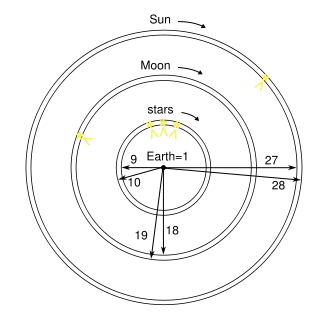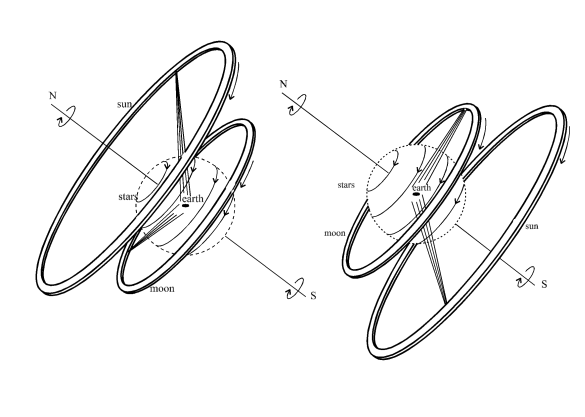<Back to Index>
- Philosopher Anaximander (Αναξίμανδρος), 610 B.C.
PAGE SPONSOR
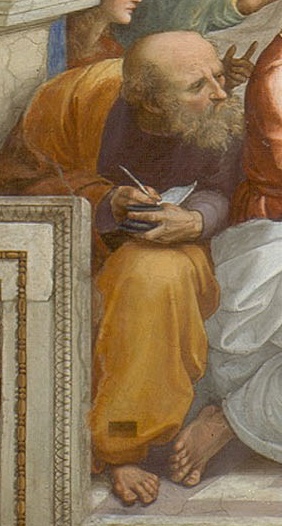
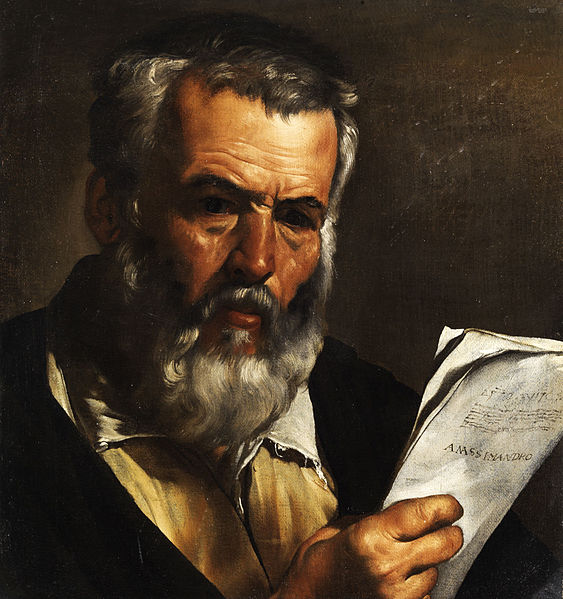
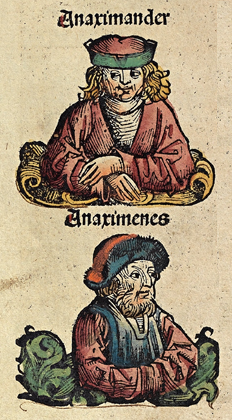
Anaximander (Ancient Greek: Ἀναξίμανδρος; c. 610 – c. 546 BC) was a pre - Socratic Greek philosopher who lived in Miletus, a city of Ionia; Milet in modern Turkey. He belonged to the Milesian school and learned the teachings of his master Thales. He succeeded Thales and became the second master of that school where he counted Anaximenes and, arguably, Pythagoras amongst his pupils.
Little of his life and work is known today. According to available historical documents, he is the first philosopher known to have written down his studies, although only one fragment of his work remains. Fragmentary testimonies found in documents after his death provide a portrait of the man.
Anaximander was one of the earliest Greek thinkers at the start of the Axial Age,
the period from approximately 700 BC to 200 BC, during which similarly
revolutionary thinking appeared in China, India, Iran, the Near East,
and Ancient Greece. He was an early proponent of science and
tried to observe and explain different aspects of the universe, with a
particular interest in its origins, claiming that nature is ruled by
laws, just like human societies, and anything that disturbs the balance
of nature does not last long. Like many thinkers of his time, Anaximander's contributions to philosophy relate to many disciplines. In astronomy,
he tried to describe the mechanics of celestial bodies in relation to
the Earth. In physics, his postulation that the indefinite (or apeiron) was the source of all things led Greek philosophy to a new level of conceptual abstraction. His knowledge of geometry allowed him to introduce the gnomon in Greece. He created a map of the world that contributed greatly to the advancement of geography. He was also involved in the politics of Miletus and was sent as a leader to one of its colonies. Anaximander claimed that an 'indefinite' (apeiron)
principle gives rise to all natural phenomena. Carl Sagan claims that
he conducted the earliest recorded scientific experiment.
Anaximander, son of Praxiades, was born in Miletus during the third year of the 42nd Olympiad (610 BC). According to Apollodorus, Greek grammarian of the 2nd century BC, he was sixty - four years old during the second year of the 58th Olympiad (547 - 546 BC), and died shortly afterwards.
Establishing a timeline of his work is now impossible, since no document provides chronological references. Themistius, a 4th century Byzantine rhethorician,
mentions that he was the "first of the known Greeks to publish a
written document on nature." Therefore his texts would be amongst the
earliest written in prose, at least in the Western world. By the time of Plato, his philosophy was almost forgotten, and Aristotle, his successor Theophrastus and a few doxographers provide
us with the little information that remains. However, we know from
Aristotle that Thales, also from Miletus, precedes Anaximander. It is
debatable whether Thales actually was the teacher of Anaximander, but
there is no doubt that Anaximander was influenced by Thales' theory that
everything is derived from water. One thing that is not debatable is
that even the ancient Greeks considered Anaximander to be from the
Monist school which began in Miletus with Thales followed by Anaximander
and finished with Anaximenes. 3rd century Roman rhetorician Aelian depicts him as leader of the Milesian colony to Apollonia on the Black Sea coast, and hence some have inferred that he was a prominent citizen. Indeed, Various History explains that philosophers sometimes also dealt with political
matters. It is very likely that leaders of Miletus sent him there as a
legislator to create a constitution or simply to maintain the colony’s
allegiance.
Anaximander's theories were influenced by the Greek mythical tradition, and by some ideas of Thales – the father of philosophy – as well as by observations made by older civilizations in the East (especially by the Babylonian astrologists). All these were elaborated rationally. In his desire to find some universal principle, he assumed like traditional religion the existence of a cosmic order and in elaborating his ideas on this he used the old mythical language which ascribed divine control to various spheres of reality. This was a common practice for the Greek philosophers in a society which saw gods everywhere, therefore they could fit their ideas into a tolerably elastic system.
Some scholars saw a gap between the existing mythical and the new rational way of thought which is the main characteristic of the archaic period (8th to 6th century BC) in the Greek city states. Because of this, they did not hesitate to speak for a 'Greek miracle'. But if we follow carefully the course of Anaximander's ideas, we will notice that there was not such an abrupt break as initially appears. The basic elements of nature (water, air, fire, earth) which the first Greek philosophers believed that constituted the universe represent in fact the primordial forces of previous thought. Their collision produced what the mythical tradition had called cosmic harmony. In the old cosmogonies – Hesiod (8th - 7th century BC) and Pherecydes (6th century BC) – Zeus establishes his order in the world by destroying the powers which were threatening this harmony (the Titans). Anaximander claimed that the cosmic order is not monarchic but geometric and this causes the equilibrium of the earth which is lying in the centre of the universe. This is the projection on nature of a new political order and a new space organized around a center which is the static point of the system in the society as in nature. In this space there is isonomy (equal rights) and all the forces are symmetrical and transferable. The decisions are now taken by the assembly of demos in the agora which is lying in the middle of the city.
The same rational way of thought led him to introduce the abstract apeiron (indefinite, infinite, boundless, unlimited) as an origin of the universe, a concept that is probably influenced by the original Chaos (gaping void, abyss, formless state) of the mythical Greek cosmogony from which everything else appeared. It
also takes notice of the mutual changes between the four elements.
Origin, then, must be something else unlimited in its source, that could
create without experiencing decay, so that genesis would never stop.
The bishop Hippolytus of Rome, and the later 6th century Byzantine philosopher Simplicius of Cilicia, attribute to Anaximander the earliest use of the word apeíron (ἄπειρον, infinite or limitless) to designate the original principle. He was the first philosopher to employ, in a philosophical context, the term arkhế (ἀρχή), which until then had meant beginning or origin. For him, it became no longer a mere point in time, but a source that could perpetually give birth to whatever will be. The indefiniteness is spatial in early usages as in Homer (indefinite sea) and as in Xenophanes (6th century BC) who said that the earth went down indefinitely (to apeiron), i.e., beyond the imagination or concept of men.
Aristotle writes (Metaphysics) that the Pre - Socratics were searching for the element that constitutes all things. While each pre - Socratic philosopher gave a different answer as to the identity of this element (water for Thales and air for Anaximenes), Anaximander understood the beginning or first principle to be an endless, unlimited primordial mass (apeiron), subject to neither old age nor decay, that perpetually yielded fresh materials from which everything we perceive is derived. He proposed the theory of the apeiron in direct response to the earlier theory of his teacher, Thales, who had claimed that the primary substance was water. The notion of temporal infinity was familiar to the Greek mind from remote antiquity in the religious concept of immortality and Anaximander's description was in terms appropriate to this conception. This arche is called "eternal and ageless" (Hippolitus).
For Anaximander, the principle of things, the constituent of all substances, is nothing determined and not an element such as water in Thales' view. Neither is it something halfway between air and water, or between air and fire, thicker than air and fire, or more subtle than water and earth. Anaximander argues that water cannot embrace all of the opposites found in nature — for example, water can only be wet, never dry — and therefore cannot be the one primary substance; nor could any of the other candidates. He postulated the apeiron as a substance that, although not directly perceptible to us, could explain the opposites he saw around him.
Anaximander explains how the four elements of ancient physics (air, earth, water and fire) are formed, and how Earth and terrestrial beings are formed through their interactions. Unlike other Pre - Socratics, he never defines this principle precisely, and it has generally been understood (e.g., by Aristotle and by Saint Augustine) as a sort of primal chaos. According to him, the Universe originates in the separation of opposites in the primordial matter. It embraces the opposites of hot and cold, wet and dry, and directs the movement of things; an entire host of shapes and differences then grow that are found in "all the worlds" (for he believed there were many).
Anaximander maintains that all dying things are returning to the element from which they came (apeiron). The one surviving fragment of Anaximander's writing deals with this matter. Simplicius transmitted it as a quotation, which describes the balanced and mutual changes of the elements:
Whence things have their origin,
Thence also their destruction happens,
According to necessity;
For they give to each other justice and recompense
For their injustice
In conformity with the ordinance of Time.
Simplicius
mentions that Anaximander said all these "in poetic terms", meaning
that he used the old mythical language. The goddess Justice (Dike)
keeps the cosmic order. This concept of returning to the element of
origin was often revisited afterwards, notably by Aristotle, and by the Greek tragedian Euripides: "what comes from earth must return to earth." Friedrich Nietzsche, in his Philosophy in the Tragic Age of the Greeks,
stated that Anaximander viewed "...all coming - to - be as though it were
an illegitimate emancipation from eternal being, a wrong for which
destruction is the only penance."
Anaximander's bold use of non - mythological explanatory hypotheses considerably distinguishes him from previous cosmology writers such as Hesiod. It confirms that pre - Socratic philosophers were making an early effort to demythify physical processes. His major contribution to history was writing the oldest prose document about the Universe and the origins of life; for this he is often called the "Father of Cosmology" and founder of astronomy. However, pseudo - Plutarch states that he still viewed celestial bodies as deities.
Anaximander was the first to conceive a mechanical model of the world. In his model, the Earth floats very still in the center of the infinite, not supported by anything. It remains "in the same place because of its indifference", a point of view that Aristotle considered ingenious, but false, in On the Heavens. Its curious shape is that of a cylinder with a height one - third of its diameter. The flat top forms the inhabited world, which is surrounded by a circular oceanic mass.
Such a model allowed the concept that celestial bodies could
pass under it. It goes further than Thales’ claim of a world floating
on water, for which Thales faced the problem of explaining what would
contain this ocean, while Anaximander solved it by introducing his
concept of infinite (apeiron).
At the origin, after the separation of hot and cold, a ball of flame appeared that surrounded Earth like bark on a tree. This ball broke apart to form the rest of the Universe. It resembled a system of hollow concentric wheels, filled with fire, with the rims pierced by holes like those of a flute. Consequently, the Sun was the fire that one could see through a hole the same size as the Earth on the farthest wheel, and an eclipse corresponded with the occlusion of that hole. The diameter of the solar wheel was twenty - seven times that of the Earth (or twenty - eight, depending on the sources) and the lunar wheel, whose fire was less intense, eighteen (or nineteen) times. Its hole could change shape, thus explaining lunar phases. The stars and the planets, located closer, followed the same model.
Anaximander
was the first astronomer to consider the Sun as a huge mass, and
consequently, to realize how far from Earth it might be, and the first
to present a system where the celestial bodies turned at different
distances. Furthermore, according to Diogenes Laertius, he built
a celestial sphere. This invention undoubtedly made him the first to realize the obliquity of the Zodiac as the Roman philosopher Pliny the Elder reports in Natural History. It is a little early to use the term ecliptic,
but his knowledge and work on astronomy confirm that he must have
observed the inclination of the celestial sphere in relation to the
plane of the Earth to explain the seasons. The doxographer and theologian Aetius attributes to Pythagoras the exact measurement of the obliquity.
According to Simplicius, Anaximander already speculated on the plurality of worlds, similar to atomists Leucippus and Democritus, and later philosopher Epicurus. These thinkers supposed that worlds appeared and disappeared for a while, and that some were born when others perished. They claimed that this movement was eternal, "for without movement, there can be no generation, no destruction".
In addition to Simplicius, Hippolytus reports Anaximander's claim that from the infinite comes the principle of beings, which themselves come from the heavens and the worlds (several doxographers use the plural when this philosopher is referring to the worlds within, which are often infinite in quantity). Cicero writes that he attributes different gods to the countless worlds.
This theory places Anaximander close to the Atomists and the Epicureans who, more than a century later, also claimed that an infinity of worlds appeared and disappeared. In the timeline of the Greek history of thought, some thinkers conceptualized a single world (Plato, Aristotle, Anaxagoras and Archelaus),
while others instead speculated on the existence of a series of worlds,
continuous or non - continuous (Anaximenes, Heraclitus, Empedocles and Diogenes).
Anaximander attributed some phenomena, such as thunder and lightning, to the intervention of elements, rather than to divine causes. In his system, thunder results from the shock of clouds hitting each other; the loudness of the sound is proportionate with that of the shock. Thunder without lightning is the result of the wind being too weak to emit any flame, but strong enough to produce a sound. A flash of lightning without thunder is a jolt of the air that disperses and falls, allowing a less active fire to break free. Thunderbolts are the result of a thicker and more violent air flow.
He saw the sea as a remnant of the mass of humidity that once surrounded Earth. A
part of that mass evaporated under the sun's action, thus causing the
winds and even the rotation of the celestial bodies, which he believed
were attracted to places where water is more abundant. He explained rain as a product of the humidity pumped up from Earth by the sun. For
him, the Earth was slowly drying up and water only remained in the
deepest regions, which someday would go dry as well. According to
Aristotle's Meteorology, Democritus also shared this opinion.
Anaximander speculated about the beginnings and origin of animal life. Taking into account the existence of fossils, he claimed that animals sprang out of the sea long ago. The first animals were born trapped in a spiny bark, but as they got older, the bark would dry up and break. As the early humidity evaporated, dry land emerged and, in time, humankind had to adapt. The 3rd century Roman writer Censorinus reports:
Anaximander of Miletus considered that from warmed up water and earth emerged either fish or entirely fishlike animals. Inside these animals, men took form and embryos were held prisoners until puberty; only then, after these animals burst open, could men and women come out, now able to feed themselves.
Anaximander put forward the idea that humans had to spend part of this transition inside the mouths of big fish to protect themselves from the Earth's climate until they could come out in open air and lose their scales. He thought that, considering humans' extended infancy, we could not have survived in the primeval world in the same manner we do presently.
Even though he had no theory of natural selection,
some people consider him as evolution's most ancient proponent. The
theory of an aquatic descent of man was re-conceived centuries later as
the aquatic ape hypothesis.
These pre - Darwinian concepts may seem strange, considering modern
knowledge and scientific methods, because they present complete
explanations of the universe while using bold and hard to demonstrate
hypotheses. However, they illustrate the beginning of a phenomenon
sometimes called the "Greek miracle": men try to explain the nature of
the world, not with the aid of myths or religion, but with material
principles. This is the very principle of scientific thought, which was
later advanced further by improved research methods.
Both Strabo and Agathemerus (later Greek geographers) claim that, according to the geographer Eratosthenes, Anaximander was the first to publish a map of the world. The map probably inspired the Greek historian Hecataeus of Miletus to draw a more accurate version. Strabo viewed both as the first geographers after Homer.
Maps were produced in ancient times, also notably in Egypt, Lydia, the Middle East, and Babylon. Only some small examples survived until today. The unique example of a world map comes from late Babylonian tablet BM 92687 later than 9th century BCE but is based probably on a much older map. These maps indicated directions, roads, towns, borders, and geological features. Anaximander's innovation was to represent the entire inhabited land known to the ancient Greeks.
Such an accomplishment is more significant than it at first appears. Anaximander most likely drew this map for three reasons. First, it could be used to improve navigation and trade between Miletus's colonies and other colonies around the Mediterranean Sea and Black Sea. Second, Thales would probably have found it easier to convince the Ionian city - states to join in a federation in order to push the Median threat away if he possessed such a tool. Finally, the philosophical idea of a global representation of the world simply for the sake of knowledge was reason enough to design one.
Surely
aware of the sea's convexity, he may have designed his map on a
slightly rounded metal surface. The centre or “navel” of the world (ὀμφαλός γῆς, omphalós gẽs) could have been Delphi, but is more likely in Anaximander's time to have been located near Miletus. The Aegean Sea was
near the map's center and enclosed by three continents, themselves
located in the middle of the ocean and isolated like islands by sea and
rivers. Europe was bordered on the south by the Mediterranean Sea and was separated from Asia by the Black Sea, the Lake Maeotis, and, further east, either by the Phasis River (now called the Rioni) or the Tanais. The Nile flowed south into the ocean, separating Libya (which was the name for the part of the then known African continent) from Asia.
The Suda relates that Anaximander explained some basic notions of geometry. It also mentions his interest in the measurement of time and associates him with the introduction in Greece of the gnomon. In Lacedaemon, he participated in the construction, or at least in the adjustment, of sundials to indicate solstices and equinoxes. Indeed, a gnomon required adjustments from a place to another because of the difference in latitude. In his time, the gnomon was simply a vertical pillar or rod mounted on a horizontal plane. The position of its shadow on the plane indicated the time of day. As it moves through its apparent course, the sun draws a curve with the tip of the projected shadow, which is shortest at noon, when pointing due south. The variation in the tip’s position at noon indicates the solar time and the seasons; the shadow is longest on the winter solstice and shortest on the summer solstice.
However, the invention of the gnomon itself cannot be attributed to Anaximander because its use, as well as the division of days into twelve parts, came from the Babylonians. It is they, according to Herodotus' Histories, who gave the Greeks the art of time measurement. It is likely that he was not the first to determine the solstices, because no calculation is necessary. On the other hand, equinoxes do not correspond to the middle point between the positions during solstices, as the Babylonians thought. As the Suda seems to suggest, it is very likely that with his knowledge of geometry, he became the first Greek to accurately determine the equinoxes.
In his philosophical work De Divinatione, Cicero states that Anaximander convinced the inhabitants of Lacedaemon to abandon their city and spend the night in the country with their weapons because an earthquake was near. The city collapsed when the top of the Taygetus split
like the stern of a ship. Pliny the Elder also mentions this anecdote,
suggesting that it came from an "admirable inspiration", as
opposed to Cicero, who did not associate the prediction with divination.
Bertrand Russell in the History of Western Philosophy interprets Anaximander's theories as an assertion of the necessity of an appropriate balance between earth, fire, and water, all of which may be independently seeking to aggrandize their proportions relative to the others. Anaximander seems to express his belief that a natural order ensures balance between these elements, that where there was fire, ashes (earth) now exist. His Greek peers echoed this sentiment with their belief in natural boundaries beyond which not even their gods could operate.
Friedrich Nietzsche, in Philosophy in the Tragic Age of the Greeks, claimed that Anaximander was a pessimist who asserted that the primal being of the world was a state of indefiniteness. In accordance with this, anything definite has to eventually pass back into indefiniteness. In other words, Anaximander viewed "...all coming - to - be as though it were an illegitimate emancipation from eternal being, a wrong for which destruction is the only penance". The world of individual objects, in this way of thinking, has no worth and should perish.
Martin Heidegger lectured extensively on Anaximander, and delivered a lecture entitled "Anaximander's Saying" which was subsequently included in Off the Beaten Track. The lecture examines the ontological difference and the oblivion of Being or Dasein in the context of the Anaximander fragment. Heidegger's lecture is, in turn, an important influence on the French philosopher Jacques Derrida.
